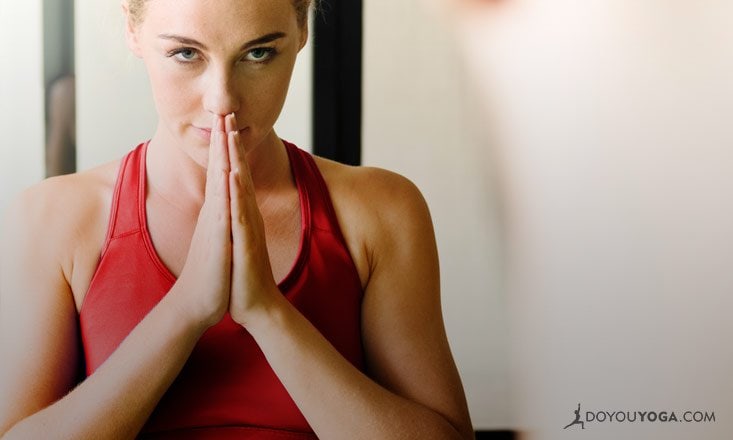Eyestrain, also known as asthenopia, is a common condition where the eyes get tired from overuse. It can result from numerous causes including reading in dim lighting or without pausing, driving long distances, exposure to bright light or glare, stress, fatigue, and staring at digital device screens or monitors.
Manifestations of eyestrain include fatigue, pain in or around the eyes, blurred or double vision, headache, watery or dry eyes, increased sensitivity to light, difficulty concentrating, trouble keeping the eyes open, sore neck, and pain in the shoulders and/or back.
Eyestrain is generally not serious and will go away after resting the eyes. If it is persistent, it is good to see a doctor to make sure there is no underlying eye condition that needs treatment.
While temporary, eyestrain can be frustrating and annoying. Here are five yogic exercises to ease eye strain, help relieve the stress and proactively take care of the eyes.
1. Intentionally Blink
The adage “blink and you will miss it” is a great mantra to help focus on the present and ground into the moment. However, without blinking, the eyes dry out, become irritated, and fatigue faster.
Take note: two or more hours of consistent daily computer and other digital device usage is a major contributor to eyestrain. The phenomenon was named computer vision syndrome or digital eyestrain by the American Optometric Association.
Digital devices place more strain on the eyes than reading print material because of the tendency to blink less while using digital devices which, subsequently, dries out the eyes. Normally people blink an average of 15-20 times per minute; however, while working at a computer, people blink a third as often as normal.
Blinking intentionally can help the eyes have a moment of rest and rejuvenation. Blinking the eyes 10 times rapidly exercises the nerves of the eyes and promotes relaxation. Slowly blinking 5-10 times, paired with breath work and focusing of energy inward, calms the nervous system.
2. Let the Good Eyes Roll
To be balanced and relaxed, the eyes also need to be moved intentionally and with compassion. For all of the exercises, maintain an upright, stable, and centered head, neck, and shoulders.
Soften the gaze and relax the muscles in the face, specifically the eyes. Start with up and down viewing: inhale-look up and exhale-look down. Then move to sideways viewing: inhale-look to the right, and exhale-look to the left.
Finally: look up and slowly circle the eyes in a clockwise motion in a smooth and fluid fashion for 3-5 cycles. Close the eyes and relax for a moment. Then repeat the up and down movement as well as the sideways viewing — this time, inhale looking to the left and exhale looking to the right and end with 3-5 counterclockwise circles.
3. 20-20(-20) Vision
Focusing at a single distance close to the face is a common occurrence for people who need to use a computer or smart phone. The eyes focus and process material on a digital screen closer and for longer periods of time than ever before.
After reading or staring at something relatively close in proximity, like the phone or a computer screen, help reduce fatigue in the eyes and relax the muscles inside the eyes by practicing the 20-20-20 technique.
Every 20-minutes look at a distant object that is about 20-feet away for at least 20-seconds.
4. The Dynamic Drishti Duo
20-20-20 technique invites the practice of looking up and softening the intense gaze often placed on a single screen or monitor. The Dynamic Drishti Duo involves more intentionally looking near and far.
With intention, this drishti (gaze) practice involves picking a point at a distance and a point closer to the self, and practicing shifting the gaze from one point to the other.
First gazing at a distant object, notice the details of the object with relaxed eyes and take a deep breath, with the exhale shift the gaze to a closer object (within reach) and notice that object with relaxed eyes. With the next deep breath, gaze back at the distant object.
Repeat this dynamic drishti shift between the two objects for at least 10 deep breaths.
5. Helping Hands
Sometimes referred to as palming, this technique involves tapping into the inner energy and rubbing the hands together for about 10-20 seconds until they feel energized and warm.
The hands are often considered how energy from within the self is shared with the world and others and the eyes are often considered as how energy from the world and others is shared with the self.
This technique is a form of biofeedback and can improve eye circulation. Once the hands are warmed, place slightly hallowed hands with the palms of the hands gently on closed eyes and the fingertips resting lightly on the forehead.
This technique can be enhanced by imagining the eyes absorbing all the warm healing energy from within and intentionally setting out to utilize this time for reflection and self-compassion. When ready, allow the eyes to blink open in the hands and slowly absorb a little light at a time as the hands slowly move away from the face.
Have fun practicing these exercise to your daily life and feel free to share any of your favorite yoga exercise for eye strain and eye health!


